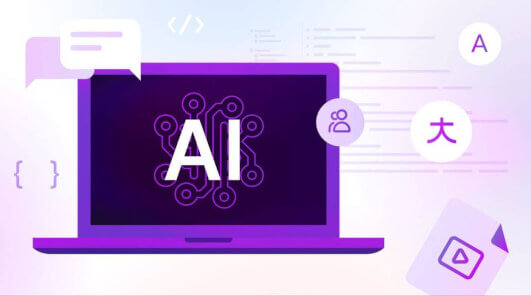Localization, the creation of content that aligns with an audience’s language, idioms, cultural references, and preferences, is key for organizations seeking to resonate and engage with users, increase market expansion, optimize the user experience, and increase conversions.
The dawn of AI has automated and streamlined many processes in translation and localization, which has consequently improved the user experience for local markets and driven business results to new, previously unattainable highs.
Ready to learn more about AI translation and localization? Then let’s jump in.
The role of AI in localization
Before machine translation, the localization of an organization’s content was a time-consuming and intensive process requiring numerous resources and large budgets to ensure its success. Whether the content being localized was public-facing, such as marketing materials, or designed for internal use, like employee training manuals, localization involved extensive research, line-by-line human translation, and proofreading by editors. Legacy translation setups using third-party agencies to handle projects also added to the cost and duration of translations, thwarted collaboration, and limited scalability, due to their reliance on manual processes.
The emergence of AI has changed all of that, with the localization and translation of content having been taken over by machine translation (MT), natural language processing (NLP), computer vision, data mining and analytics, and machine learning (ML). These advanced AI technologies, which enable feedback loops, the automation of tasks, workflow optimization, and predictive analysis, increase the consistency of an organization’s localization efforts and streamline workflows. In turn, it enables companies to reach global audiences much more effectively than with the solely human-powered processes.
Finally, with AI advances, companies are no longer reliant on third parties to produce translations; instead, teams that utilize AI tools are in control of the translation process from end to end, boosting a company’s self-sufficiency.
How AI can transform the localization process
Let’s take a look at exactly how AI has transformed localization and translation and what you can expect from the technology currently on offer.
Speeds up translations
Accurate translation is one of the central components of localization. Creating accurate, engaging, and accessible content in the languages spoken by target audiences enables an organization to stand out from its competitors, reach wider markets, and better engage with its users.
Traditional translation methods only involving human translators not only take longer, but they can also be more costly. AI, on the other hand, speeds up the translation process through the leveraging of bilingual data and machine learning algorithms such as neural networks. Instead of a translation taking days, weeks, or months, AI technology translates in seconds, with accuracy increasing all the time. An organization’s localization strategy can therefore support targeting multiple audiences and geographies at once.
Translators can serve as subject matter experts to edit and fine-tune AI translations in AI human workflows as a means to train the algorithm to adopt a certain tone of voice or terminology.
Automates and streamlines localization workflows
The advantages AI brings to the automation and streamlining of localization workflows are diverse. Not only does AI bring powerful automation to elements such as translation, image and video localization, and customer service, but it also enables teams to scale their localization efforts while maintaining the highest level of content accuracy.
AI is able to achieve this automation and streamlining through the leveraging of machine learning algorithms and natural language processing (NLP) techniques which manage a localization process’s different activities:
translation tools powered by AI automatically translate text from one language into another;
trained algorithms seamlessly identify and translate the text elements of images and video;
automated checks for quality assurance ensure language accuracy and consistency, speeding up the whole process.
Generative AI can use previous translations to create more multilingual content
Generative AI has become a leading force in the revolution of the localization process thanks to advanced deep learning models that can create original content. When given large datasets, these algorithms identify patterns and structures that help them to produce unique outputs that resemble the original data provided.
When it comes to translation, generative AI produces multilingual translations previously unseen in the inputted data, incorporating the original language’s tone, style, and, of course, meaning. In addition to the generation of multilingual content, this technology can enhance and improve a linguist’s work, increase the accuracy of translations, and speed up tasks.
Localizes multimedia content
While translating text is a hugely important part of any localization strategy, without adapting images, videos, files, and other media, an organization’s visual content can fail its intended audiences by appearing irrelevant, unrelatable, or hard to understand. By harnessing AI technologies, an organization can localize its multimedia content to effectively communicate with a diverse range of users.
Here are some examples of how AI can localize your multimedia content:
AI algorithms can sweep a website for images, recognize text within those images, and translate and localize those words in real time;
When trained in object detection, AI tools can identify and replace objects within images or videos with region-specific objects for increased cultural relevance and understanding;
AI-powered scene understanding technology analyzes and identifies scenes that don’t fit the region of the target audience and replaces them with culturally relevant scenes;
AI can use voice or audio processing techniques to adjust accents, dialects, or even music to better match those of the audience’s region;
AI-powered video editing automation tools can identify and replace video-based text like subtitles and text overlays;
AI technology can be trained to flag website content or materials that might be deemed insensitive or inappropriate in specific regions.
Enables personalization
Personalization and localization are intrinsically linked, with both approaches seeking to enhance engagement through the creation of content that meets specific user needs and preferences. When an organization incorporates personalization into its localization strategy, engagement rates soar. This is because users don’t just recognize the language, setting, and terminology that’s incorporated into the content, they also feel as though that content was designed specifically for them.
AI technology can offer marketers and L&D teams significant support in the process of personalizing user content by swiftly analyzing user behavior, preferences, and characteristics that enable the tool to deliver tailored content and experiences in moments. This data analysis also enables the AI to suggest recommendations of products, content, or services that a user is likely to be genuinely interested in.
Customized customer support via chatbots and virtual assistants is another advantage enabled by AI’s natural language processing technology, with chatbot-human interactions feeling natural and relevant to users.
Boosts the user experience with chatbots
AI chatbots are becoming an increasingly popular tool used by organizations seeking to boost a user’s individual experience with a brand. This is because AI chatbots and virtual assistants can be trained to work in multiple languages and instantaneously access and deliver relevant information to specific groups of people.
Chatbots can boost a localization strategy by:
Offering multilingual support to users and customers;
Adjusting chat responses to match regional language differences;
Using terminology recognized in particular regions;
Providing location-specific details, recommendations, and services;
Using familiar cultural references;
Avoiding language that could be deemed insensitive to particular cultures;
Offering examples, scenarios, and use cases that individuals from specific regions can easily recognize and relate to.
AI chatbots enable businesses to reach wider and more diverse audiences, promote inclusion, and enhance each individual’s user experience with a brand. Compared to human customer service agents, AI tools can deliver faster turnaround times and communicate the information each specific user needs in their chosen language.
Enhances on-page SEO
On-page SEO soars when using region-specific references, recognizable terminology, and familiar images and scenarios. It boosts the chance of a site being on the first page of a search engine’s results pages.
With the support of AI technology localizing content, a website is much more likely to:
Be found by those searching for your content
Rank more highly than your competitors
Receive more overall traffic
Boost brand recognition and trust
AI tools help enhance on-page SEO by suggesting localized content prompts, using recognizable terminology and language, writing region-specific blog posts, and providing location-specific data to support the creation of tips and recommendations for users in specific regions.
Provides data-driven insights
When fed with user data, AI tools can identify trends and patterns in user behavior, preferences, location, and language. With this information, businesses are able to make much more informed decisions regarding how to best localize content and engage with users.
Examples of how AI can produce data-driven insights include:
The analysis of engagement metrics to learn which localized content is most effectively engaging the audiences being targeted
The analysis of social media conversions to gain a clearer understanding of public opinion
The analysis of language and regional preferences to help organizations understand and prioritize particular languages or areas in their localization strategies
Sentiment analysis to analyze social media reviews, feedback, and comments to understand how culturally sensitive a company’s content output is
Ensures cultural sensitivity through analysis
Ensuring cultural sensitivity is an important part of the localization process. By reviewing and creating content with cultural sensitivity in mind, an organization can ensure that public-facing content is both respectful and relevant to its intended audience. When this part of the process is neglected, an organization might unintentionally offend or alienate its target audience, negatively impacting the brand’s reputation, popularity, and sales.
Cultural sensitivity also plays a role internally. Potential job candidates are more likely to want to work for a company that demonstrates cultural sensitivity in its content as this shows a company’s commitment to inclusion and diversity; a factor impacting job application decisions from younger generations of jobseekers in particular.
Why you should use Smartcat AI
Smartcat AI translation allows you to transform your content into any language in seconds, irrespective of format. From documents to videos, its multilingual enterprise library enables you to create new content in multiple languages at speed. At the same time, adaptive AI remembers your team’s updates such as tone of voice, style, and terminology. In addition, the tool can recreate your brand’s voice and use your preferred terminology, ensuring the continuous improvement and consistency of content outcomes.
An AI-powered, embedded marketplace of linguists and editors smooths the final editing process, with an AI-matching algorithm securing the talent you need for your content’s proofing before being handed over for implementation.
With instantaneous results, continuously improving quality, easy scalability, and universal DIY application, Smartcat’s AI translation tool supports teams in transforming their localization process effortlessly, saving organizations time and money.
Subscribe to our newsletter


